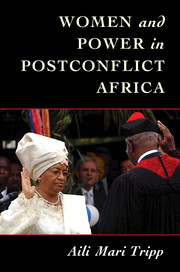Book contents
- Frontmatter
- Epigraph
- Dedication
- Contents
- List of Tables
- List of Figures
- Map of Africa
- List of Acronyms
- Acknowledgments
- Preface
- Part I Setting the Stage
- Part II Case Studies
- Part III New Openings for Women's Rights
- Part IV Gendered Outcomes
- Part V Future Research
- 10 New Frontiers in the Study of Women, Conflict, and Peace
- References
- Index
10 - New Frontiers in the Study of Women, Conflict, and Peace
from Part V - Future Research
Published online by Cambridge University Press: 05 November 2015
- Frontmatter
- Epigraph
- Dedication
- Contents
- List of Tables
- List of Figures
- Map of Africa
- List of Acronyms
- Acknowledgments
- Preface
- Part I Setting the Stage
- Part II Case Studies
- Part III New Openings for Women's Rights
- Part IV Gendered Outcomes
- Part V Future Research
- 10 New Frontiers in the Study of Women, Conflict, and Peace
- References
- Index
Summary
I remember the leaders of the Women's Movement saying,
we must stop dancing from the side
we are done with
begging
lobbying
talking
negotiating.
We are tired of being children of a lesser god
we must operate from the centre
we must live our dreams, they said
I remember the leaders saying
we must negotiate the double covenant
we must decide on
our destiny and that of our people.
I remember that was the day the lord hath made
the women rejoiced and were glad in her
from that day henceforth the women moved to the centre, their centre
it is now time for harvest.
– Wanjiku Kabira, excerpted from “Grandma Remembers,” Time for Harvest, 2012This book has pursued one key question: Why are women's rights and rates of leadership improving more rapidly in postconflict countries in Africa than elsewhere on the continent, particularly in countries that have experienced major conflict? This chapter takes the key findings and situates them in a broader frame of gender regime change. It points to where this study takes us and what new unexplored issues emerge from this study.
At one level, the book argues that a combination of factors needs to be considered in linking postconflict dynamics with women's rights in Africa after the 1990s. They include disruptions in gender roles during conflict, the role of autonomous women's movements enabled by political opening, and changing international norms and UN pressures on governments.
Changing opportunity structures that limit or, in this case, facilitate social movements – in the form of peace negotiations and constitutional and electoral processes – allowed women's organizations to intervene in new ways to assert their interests, particularly a gender agenda. This was because the end of conflict shook up leadership structures, thus necessitating institutional change. Gaining power was at the core of the strategy of women activists because it was key to realizing their other demands.
At another level, this book is about a much bigger story that has to do with how gender regime change occurs. Laura Shepherd (2008) has argued that violence in war is gendered but it also creates gender. This book has shown that violence in the context of war, depending on other circumstances, can also disrupt and transform gender power relations.
- Type
- Chapter
- Information
- Women and Power in Postconflict Africa , pp. 235 - 257Publisher: Cambridge University PressPrint publication year: 2015

